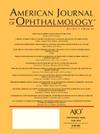基于眼血流动力学的脑图预测缺血性脑卒中。
IF 4.1
1区 医学
Q1 OPHTHALMOLOGY
引用次数: 0
摘要
目的:缺血性脑卒中是一种病死率高、致残率高的脑血管疾病。由于生理特征相似,眼部血管特征是监测脑血管疾病的重要指标。本研究旨在建立一种基于眼血流动力学特征的缺血性脑卒中nomogram预测模型。设计:回顾性临床队列研究。方法:共纳入337例患者,随机分为253个训练组和102个验证组。收集一般资料,超声检测眼动脉、视网膜中央动脉、睫状体后动脉血流动力学参数。从彩色眼底图像中提取视网膜血管直径,收集患者的相关实验室指标。采用Logistic回归分析确定缺血性脑卒中的危险因素。根据确定的危险因素构建nomogram,并采用受试者工作曲线(ROC)、Hosmer-Lemeshow检验和决策曲线分析(decision curve analysis, DCA)分析模型的准确性和临床适用性。结果:缺血性卒中的独立危险因素包括高血压(OR 2.17, 95%可信区间[CI] 1.16 ~ 4.08;P = 0.016),高脂血症(OR 2.21, 95% CI 1.18 ~ 4.14;P = 0.013),眼动脉阻力指数(OR 5.98, 95% CI 3.27 ~ 10.93;P < 0.001)。训练组ROC曲线下面积为0.790 (95% CI 0.733 ~ 0.847),验证组ROC曲线下面积为0.773 (95% CI 0.679 ~ 0.866),说明nomogram预测缺血性卒中的能力一致。训练队列和验证队列的平均绝对误差分别为0.020和0.013。此外,DCA曲线显示了良好的临床效益。结论:结合传统因素与眼动脉阻力指数的nomogram预测缺血性脑卒中具有较好的预测效果。提示该模型结合眼血流动力学可有效促进缺血性脑卒中的早期诊断和干预。本文章由计算机程序翻译,如有差异,请以英文原文为准。
A Nomogram Based on Ocular Hemodynamics for Predicting Ischemic Stroke
PURPOSE
Ischemic stroke is a cerebrovascular disease with high mortality and disability. Due to similar physiological characteristics, ocular vascular characteristics are important indicators for monitoring cerebrovascular diseases. This study aimed to develop a nomogram prediction model for ischemic stroke based on ocular hemodynamic characteristics.
DESIGN
Retrospective clinical cohort study.
METHODS
A total of 337 patients were included in this study and randomly divided into 235 training and 102 validation cohorts. The general data were collected, and the hemodynamic parameters of ophthalmic artery, central retinal artery and posterior ciliary artery were detected by ultrasound. The retinal vascular diameter was extracted from the color fundus image, and the relevant laboratory indexes of the patients were collected. Logistic regression analysis was used to determine the risk factors of ischemic stroke. A nomogram was constructed based on the identified risk factors, and the accuracy and clinical applicability of the model were analyzed using the receiver operating curve (ROC), Hosmer-Lemeshow test, and decision curve analysis (DCA).
RESULTS
Independent risk factors for ischemic stroke including hypertension (OR 2.17, 95% confidence interval [CI] 1.16 to 4.08; P = .016), hyperlipidemia (OR 2.21, 95% CI 1.18 to 4.14; P = .013), and resistance index of ophthalmic artery (OR 5.98, 95% CI 3.27 to 10.93; P < .001) were identified by multivariate regression analysis. The area under the ROC curve of the training cohort was 0.790 (95% CI 0.733 to 0.847) and that of the validation cohort was 0.773 (95% CI 0.679 to 0.866), revealing the consistent ability of the nomogram to predict ischemic stroke. The mean absolute error of the training and validation cohorts were 0.020 and 0.013, respectively. In addition, the DCA curve showed good clinical benefit.
CONCLUSIONS
The nomogram combining traditional factors and ophthalmic artery resistance index has a preferable predictive performance for ischemic stroke. This suggests that the model combined with ocular hemodynamics can effectively promote the early diagnosis and intervention of ischemic stroke.
求助全文
通过发布文献求助,成功后即可免费获取论文全文。
去求助
来源期刊
CiteScore
9.20
自引率
7.10%
发文量
406
审稿时长
36 days
期刊介绍:
The American Journal of Ophthalmology is a peer-reviewed, scientific publication that welcomes the submission of original, previously unpublished manuscripts directed to ophthalmologists and visual science specialists describing clinical investigations, clinical observations, and clinically relevant laboratory investigations. Published monthly since 1884, the full text of the American Journal of Ophthalmology and supplementary material are also presented online at www.AJO.com and on ScienceDirect.
The American Journal of Ophthalmology publishes Full-Length Articles, Perspectives, Editorials, Correspondences, Books Reports and Announcements. Brief Reports and Case Reports are no longer published. We recommend submitting Brief Reports and Case Reports to our companion publication, the American Journal of Ophthalmology Case Reports.
Manuscripts are accepted with the understanding that they have not been and will not be published elsewhere substantially in any format, and that there are no ethical problems with the content or data collection. Authors may be requested to produce the data upon which the manuscript is based and to answer expeditiously any questions about the manuscript or its authors.

 求助内容:
求助内容: 应助结果提醒方式:
应助结果提醒方式:


